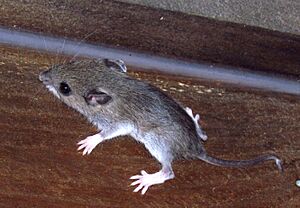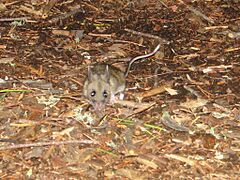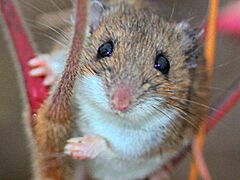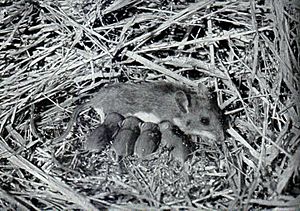White-footed mouse facts for kids
Quick facts for kids White-footed mouse |
|
|---|---|
 |
|
| Conservation status | |
| Scientific classification | |
| Genus: |
Peromyscus
|
| Species: |
leucopus
|
 |
|
The white-footed mouse (Peromyscus leucopus) is a small rodent that lives in North America. You can find them from southern Canada all the way down to the southwestern United States and Mexico. In some places, like Texas, people also call them the woodmouse.
Contents
What Does a White-Footed Mouse Look Like?
Adult white-footed mice are about 9 to 10 centimeters (about 3.5 to 4 inches) long. This measurement does not include their tail, which can add another 6 to 10 centimeters (about 2.5 to 4 inches) to their length! A young adult mouse usually weighs between 20 and 30 grams (less than an ounce).
While some mice can live for a long time (up to 96 months, or 8 years), most white-footed mice in the wild live for about 1 to 2 years, especially in colder areas. This species looks a lot like another mouse called Peromyscus maniculatus.
-
A white-footed mouse in Quetico Provincial Park, Ontario
-
A female mouse on a staghorn sumac plant
Behavior and Diet
White-footed mice are omnivores, which means they eat both plants and animals. Their diet includes seeds and insects. They are especially good at hunting the pupal stage (a young, developing stage) of the invasive spongy moth.
These mice are shy and usually stay away from humans. However, sometimes they might move into the ground-floor walls of homes. There, they build nests and store food. White-footed mice spend a lot of time in trees and bushes. They sometimes even use old, empty bird nests and build roofs over them!
Health and Safety
Like the North American deer mouse, white-footed mice can carry certain germs, such as hantavirus, which can make people very sick. They can also carry the bacteria that causes Lyme disease. It is important to remember that wild animals should never be touched.
The white-footed mouse is also a favorite host for a type of parasitic fly called the Cuterebra fontinella botfly.
How Humans Interact with White-Footed Mice
The white-footed mouse is one of the most common types of mice used in laboratories, after the house mouse. The mice raised in labs are called Peromyscus leucopus linville. These domesticated mice are also sometimes kept as pets and have been bred to have many different fur colors.
How City Life Changes White-Footed Mice
In big cities like New York City, white-footed mice live in small green areas, like parks. They are often separated from other mouse groups by roads and buildings. This separation has caused the city mice to change and adapt over time.
Eating Habits
City mice have learned to eat food that humans throw away. This means they eat a lot more fat and carbohydrates than mice living in the countryside. Their bodies have started to change to help them digest these new foods better. Even their teeth might be getting shorter because they don't need to chew tough foods as much.
Dealing with Pollution
City environments often have more pollution and toxins. Because of this, city mice are developing ways to handle these harmful substances. Their bodies are getting better at breaking down and getting rid of toxins. This helps them survive in polluted areas.
Stronger Immune Systems
Cities have many different kinds of germs because of all the people and travel. This means city mice are exposed to more diseases. Their immune systems are changing to become stronger and better at fighting off infections. This helps them stay healthy even with more germs around. These changes are especially noticeable because city mice don't mix much with mice from outside the city.
See also
- Monongahela virus





